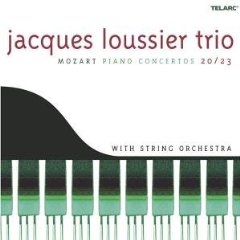Jacques Loussier Trio – Mozart Piano Concertos 20 & 23 (2005)
Jacques Loussier Trio – Mozart Piano Concertos 20 & 23 (2005)

01. Concerto No.20 in D Minor, KV 466: I. Allegro 02. Concerto No.20 in D Minor, KV 466: II. Romance 03. Concerto No.20 in D Minor, KV 466: III. Rondo presto 04. Concerto No.23 in A Major, KV 488: I. Allegro 05. Concerto No.23 in A Major, KV 488: II. Adagio 06. Concerto No.23 in A Major, KV 488: III. Allegro assai André Arpino - Drums Jean Claude Auclin - Cello David Braccini - Violin Benoit Dunoyer de Segonzac - Bass, Double Bass Vincent Debruyne - Viola Anne Gravoin - Violin Sylvain Le Provost - Bass, Double Bass Jacques Loussier - Arranger, Piano, Producer David Naulin - Violin Paul Rouger - Violin Jacques Saint-Yves - Violin Richard Schmoucler - Violin Renaud Stahl - Viola Mathilde Sternat - Cello Mathias Tranchant - Violin
This doesn't really work, but Jacques Loussier's attempt to make Mozart work as jazz is sufficiently complex enough to make you ask, as you're hearing it, why it isn't working, and maybe that's a worthwhile thing. As the liner notes point out, it is most often Bach among classical composers whose music has served as the basis for jazz experiments. Mozart-jazz is much rarer. Chick Corea has played Mozart piano concertos with jazz cadenzas, introducing improvisation where Mozart would have included it anyway -- a natural solution. But Loussier is more ambitious: he tries to recast the Piano Concerto No. 20 in D minor and Piano Concerto No. 23 in A major entirely as jazz. The problem is that Mozart lacks the combination of clear harmonic framework and steady rhythmic pulse that is fundamental to Bach's music. Mozart may seem to have a clear rhythmic pulse, but one key to his deceptive simplicity is that his manipulations of the listener's perception of time are both highly complex and perfectly balanced. The speed at which things are happening changes constantly but is perfectly controlled. Tamper with it, and the whole thing can fall apart.
Loussier goes to great lengths to stop that from occurring. First, he simplifies the overall picture by dropping Mozart's wind parts. Then he breaks up Mozart's flow of music into sections, treating each in a characteristic way. Mozart's opening themes are presented more or less straight, with a few syncopations and light jazz percussion added. It is in transitional material or material leading toward a transition (such as second themes and their subsidiary themes), that he sets his trio (piano, bass, and drums) loose with jazz improvisations upon Mozart's melodies and harmonic progressions. The jazz element thus partially stands in for developmental passages in which Mozart increases the tension by revving up the harmonic rhythm. This doesn't get from point A to point B as smoothly as Mozart does, but it's inventive, and Loussier's unfoldings of his ideas are interesting to follow. In rhythmically intense passages such as the opening of the last movement of the Piano Concerto No. 20 -- and only in these -- he turns the drummer loose. The opening themes to these (jazz-loving) ears just sounded bizarre, and sometimes one gets the feeling that the various elements of the music are competing with each other rather than working together. Yet Loussier did not approach his task with anything less than a full appreciation of the complexity of the job, and if he has not delivered a recording that is exactly attractive, he has shown us something of how difficult musical fusion really is when it has aims above the superficial. Any jazz musician who has wrestled with similar questions will find much to chew on here. ---James Manheim, Rovi
download (mp3 @320 kbs):
uploaded yandex 4shared mega solidfiles zalivalka cloudmailru filecloudio oboom
Zmieniony (Piątek, 28 Listopad 2014 15:29)








